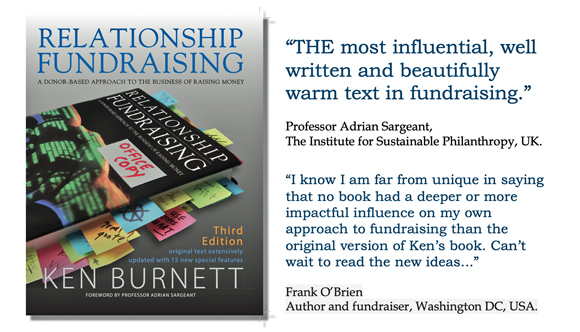| |
|
The cost of donor acquisition has been hanging above the voluntary sector like an enormous, usually hidden sword of Damocles for many years now, growing steadily bigger and more threatening. If we’re not careful, one day soon it’s going to fall and skewer us. Last week a UK fundraiser told me that it costs his charity £300+ to acquire one new donor. So it can take several years of a donor’s regular contributions before, ‘any of his or her funds are going to the cause’.
Most donors would find this a cause for concern. Most fundraisers too. But, is this the right way to look at it?
Early in my fundraising career my mentor Harold Sumption carefully explained for me the huge and crucially important difference between two true statements that add up to precisely the same thing. This inspired me hugely.
He said, ‘If we say, ‘our fundraising costs are 33 per cent of our raised income’ donors will be appalled and may wonder if our organisation deserves their support. If we say, ‘give us £1.00 and we’ll quickly turn it into £3.00 for the cause’, donors will be delighted and will gladly give.’
As usual Harold was wise and right. Often it’s not what you say but the way that you say it. But he was speaking some years back, in fundraising’s halcyon days. The equations have since got much worse, particularly in donor acquisition. Of course transparency is essential and covering up a painful reality is unforgivable. But logically donors should be steered away from the distraction of high acquisition costs by us explaining the total picture far better than we generally do. Judging a donation’s effectiveness solely on the cost of acquisition is unhelpful and misleading. For most effective charities the cost of acquisition is all but fixed and unalterable. Rather what should matter to donors is impact and efficiency, good old-fashioned ‘bang for the donor’s buck’.
We have only ourselves to blame if donors don’t understand the economics of how our enterprises work. We shouldn’t even attempt to justify acquisition costs without explaining that they are far higher than we’d like them to be, that they are a necessary cost of doing business and that like any other responsible business we do all we reasonably can to keep them down. And that our business is long-term and what we seek are mutually beneficial long-term relationships.
In other words what we should seek to answer is the big question that all donors ask, ‘What difference will my gift make?’ When they ask about acquisition costs, that’s what donors really want to know. If fundraisers fearlessly present their costs and income in total over time, showing how the lion’s share of a donor’s gift is applied to their cause, mostly we see an equation of which donors and fundraisers can be rightly proud.
It’s not the donors who say yes at the point of acquisition that cost the charity money; it’s those who say no. If everyone approached said yes, acquisition would be a very profitable business. The yeses don’t have to subsidise the nos. Why should they? Something else could. If donor acquisition were a single activity entire of itself then the yeses would of course have to subsidise the nos. But it isn’t. Acquisition is just one part of a complex financial construct that enables charities most efficiently to raise the money they need.
Money loses its identity when it reaches the bank. So what part of the organisation’s funds is really paying the cost of acquisition? A non profit could say, ‘we apply half our legacy income, or GiftAid income, or even unearmarked grants to fund the acquisition of new donors.’
And why not? If some mystery benefactor came along and said ‘I’ll fund all the nos for you’, would that reassure donors and make the financial equation for the yeses suddenly all right?
All but a few lucky or particularly popular or effective businesses have to pay to acquire customers. It’s a fact of economic life. When I buy a camera from Amazon I consider its cost relative to my perception of value for money in the camera market. I don’t reflect that that cost is hugely inflated by what Amazon has to pay to recruit me, or more accurately, for all the advertising, promotion and overhead costs it incurs in communicating with people who don’t buy their cameras.
Voluntary organisations could get much better at acquisition, no doubt. And they could get very much better at retention. For many charities who think they can’t afford to acquire new donors, retention has to become the new acquisition.
Obviously a new acquisition paradigm is needed too, the discovery of a new method or methods similar to Greenpeace’s development of face-to-face, which suddenly was 18 years ago and is now rather tired and troubled. But that will require risk-taking and investment in innovation, sensible of course but things most charities fear their donors would be reluctant to support.
So the vicious circle continues. If we have explained our commercial realities at all, we have explained them very badly.
Expensive though new donors are, not recruiting donors to replace those we lose would cost our organisations much more. Charities must recruit donors or they die. They can justify paying to do this only if the lifetime value of donors substantially exceeds the cost of acquisition, service and replacement. The trouble is that looking only at acquisition is inevitably looking at the most expensive end of a charity’s commercial reality. Rather what’s needed is an explanation for donors that takes an overall view of how much the charity raises at what cost and the average percentage of turnover that is applied net to the cause. This is the only equation that should interest a donor. With this equation most charities have a strong case that they can make, that most donors would find very reassuring or at least justifiable.
Of course charities have to be transparent, open and accountable and there is no excuse for anyone telling donors lies or in any way misleading the public about the commercial realities that charities face. Charities should be entirely accountable for deceptive fundraising done in their name. These days there is too much delegation to commercially motivated third parties of the business of talking to donors. That said, some of these third parties are more efficient and effective than charities would be themselves and all are damaged by the rogues. Charities have to be hyper-vigilant and draconian in stamping out abuse.
The issue also requires us to look at the range of acquisition methods that fundraiser’s use, their strength and rigour in testing and response analysis, their willingness to invest in acquisition when it’s working, their policies of managing suppliers and a host of other complexities. But to justify what they do charities would be wise to construct a clear case based on the net total they raise for their cause. If what we then see is not an equation that donors would accept then – assuming no government bail-out is forthcoming – the charity should pack its bags and put itself out of business.
More than this, our sector needs a common, vigorously defended position from the IoF, AFP and other reponsible bodies that’s designed to help donors judge the financial effectiveness of the charities they might support. A common standard may be challenging and difficult to agree, but we should try. It’s time for an honest, warts-and-all justification to donors of the commercial realities that charities face. It’s not going to be sustainable for much longer just to keep our heads down and hope the acquisition issue will go away. It won’t.
© Ken Burnett 2012
|
|
 This article was prompted by an anxious note sent by a friend in Canada alerting me to a series of shock horror revelations posted on the Internet recently from the USA. My friend Roger Craver of The Agitator described it as ‘An almost tsumani-like wave of major media stories on questionable nonprofit practices that has hit the shores of our sector and shows no sign of quietly fading away’. For links to these see here and here. My response opposite relates only to a part of the issues they raise, but it’s an important part in my view. This article was prompted by an anxious note sent by a friend in Canada alerting me to a series of shock horror revelations posted on the Internet recently from the USA. My friend Roger Craver of The Agitator described it as ‘An almost tsumani-like wave of major media stories on questionable nonprofit practices that has hit the shores of our sector and shows no sign of quietly fading away’. For links to these see here and here. My response opposite relates only to a part of the issues they raise, but it’s an important part in my view.
 Finding, engaging and signing up new donors is both increasingly costly and an essential part of how we do business. Hard though it may be to justify to donors, in the spirit of transparency and accountability fundraisers should get better at explaining what is nevertheless essential if non-profits are to thrive. Finding, engaging and signing up new donors is both increasingly costly and an essential part of how we do business. Hard though it may be to justify to donors, in the spirit of transparency and accountability fundraisers should get better at explaining what is nevertheless essential if non-profits are to thrive.

It’s no longer good enough to leave donors running round anxious and ill-informed, nor is it right to try to squeeze them into shapes that suit us. Accountability means fearlessly and proactively explaining what matters to all our stakeholders in language that they can understand and relate to.
  Our sector needs a common, vigorously defended position from the IoF, AFP and others designed to help donors judge the financial effectiveness of the charities they might support. A common standard may be challenging and difficult to agree, but we should try. Our sector needs a common, vigorously defended position from the IoF, AFP and others designed to help donors judge the financial effectiveness of the charities they might support. A common standard may be challenging and difficult to agree, but we should try.
It’s time for an honest, warts-and-all justification to donors of the commercial realities that charities face. It’s not going to be sustainable for much longer just to keep our heads down and hope the acquisition issue will go away. It won’t.


The Inch Hotel, Loch Ness, inspirational setting for Clayton Burnett’s transformational events.
At the time of writing Ken Burnett is co-founder of Clayton Burnett Limited, a director of The White Lion Press Limited, a consultant to The Burnett Works agency and former UK director, director of fundraising and chairman of the board of trustees for the international development charity ActionAid. He’s author of several books including Relationship Fundraising and The Zen of Fundraising and is managing trustee of SOFII, The Showcase of Fundraising Innovation and Inspiration.
For more on Ken’s books please click here.
For more on the cost of fundraising issue click here.

|


 Finding, engaging and signing up new donors is both increasingly costly and an essential part of how we do business. Hard though it may be to justify to donors, in the spirit of transparency and accountability fundraisers should get better at explaining what is nevertheless essential if non-profits are to thrive.
Finding, engaging and signing up new donors is both increasingly costly and an essential part of how we do business. Hard though it may be to justify to donors, in the spirit of transparency and accountability fundraisers should get better at explaining what is nevertheless essential if non-profits are to thrive. 


